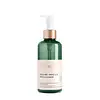What's inside
What's inside
 Key Ingredients
Key Ingredients

No key ingredients
 Benefits
Benefits

 Concerns
Concerns

 Ingredients Side-by-side
Ingredients Side-by-side

Water
Skin ConditioningAloe Barbadensis Leaf Juice
Skin ConditioningCocamidopropyl Hydroxysultaine
CleansingGlycerin
HumectantSodium Cocoyl Isethionate
CleansingDisodium Coco-Glucoside Citrate
EmulsifyingSqualane
EmollientCocoyl Proline
Skin ConditioningMoringa Oleifera Leaf Extract
Skin ConditioningRosmarinus Officinalis Leaf Oil
MaskingCymbopogon Schoenanthus Oil
MaskingPelargonium Graveolens Oil
MaskingSalvia Sclarea Oil
MaskingHydrolyzed Pea Protein
EmollientMedicago Sativa Extract
TonicSodium Levulinate
Skin ConditioningCaramel
Cosmetic ColorantMagnesium Chloride
Potassium Sorbate
PreservativeSodium Gluconate
Skin ConditioningCitric Acid
BufferingCitral
PerfumingCitronellol
PerfumingLinalool
PerfumingWater, Aloe Barbadensis Leaf Juice, Cocamidopropyl Hydroxysultaine, Glycerin, Sodium Cocoyl Isethionate, Disodium Coco-Glucoside Citrate, Squalane, Cocoyl Proline, Moringa Oleifera Leaf Extract, Rosmarinus Officinalis Leaf Oil, Cymbopogon Schoenanthus Oil, Pelargonium Graveolens Oil, Salvia Sclarea Oil, Hydrolyzed Pea Protein, Medicago Sativa Extract, Sodium Levulinate, Caramel, Magnesium Chloride, Potassium Sorbate, Sodium Gluconate, Citric Acid, Citral, Citronellol, Linalool
 Reviews
Reviews

Ingredients Explained
These ingredients are found in both products.
Ingredients higher up in an ingredient list are typically present in a larger amount.
Citric Acid is an alpha hydroxy acid (AHA) naturally found in citrus fruits like oranges, lemons, and limes.
Like other AHAs, citric acid can exfoliate skin by breaking down the bonds that hold dead skin cells together. This helps reveal smoother and brighter skin underneath.
However, this exfoliating effect only happens at high concentrations (20%) which can be hard to find in cosmetic products.
Due to this, citric acid is usually included in small amounts as a pH adjuster. This helps keep products slightly more acidic and compatible with skin's natural pH.
In skincare formulas, citric acid can:
While it can provide some skin benefits, research shows lactic acid and glycolic acid are generally more effective and less irritating exfoliants.
Most citric acid used in skincare today is made by fermenting sugars (usually from molasses). This synthetic version is identical to the natural citrus form but easier to stabilize and use in formulations.
Read more about some other popular AHA's here:
Learn more about Citric AcidWater. It's the most common cosmetic ingredient of all. You'll usually see it at the top of ingredient lists, meaning that it makes up the largest part of the product.
So why is it so popular? Water most often acts as a solvent - this means that it helps dissolve other ingredients into the formulation.
You'll also recognize water as that liquid we all need to stay alive. If you see this, drink a glass of water. Stay hydrated!
Learn more about Water